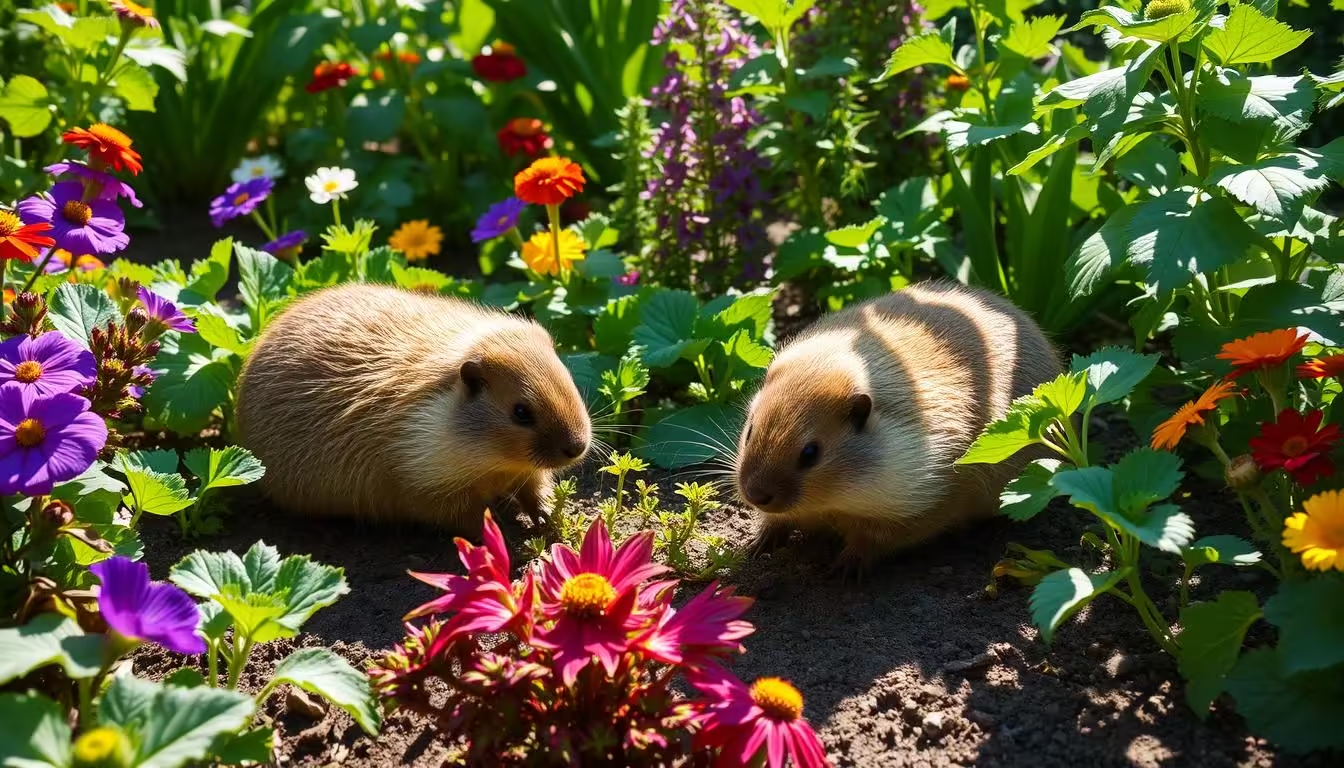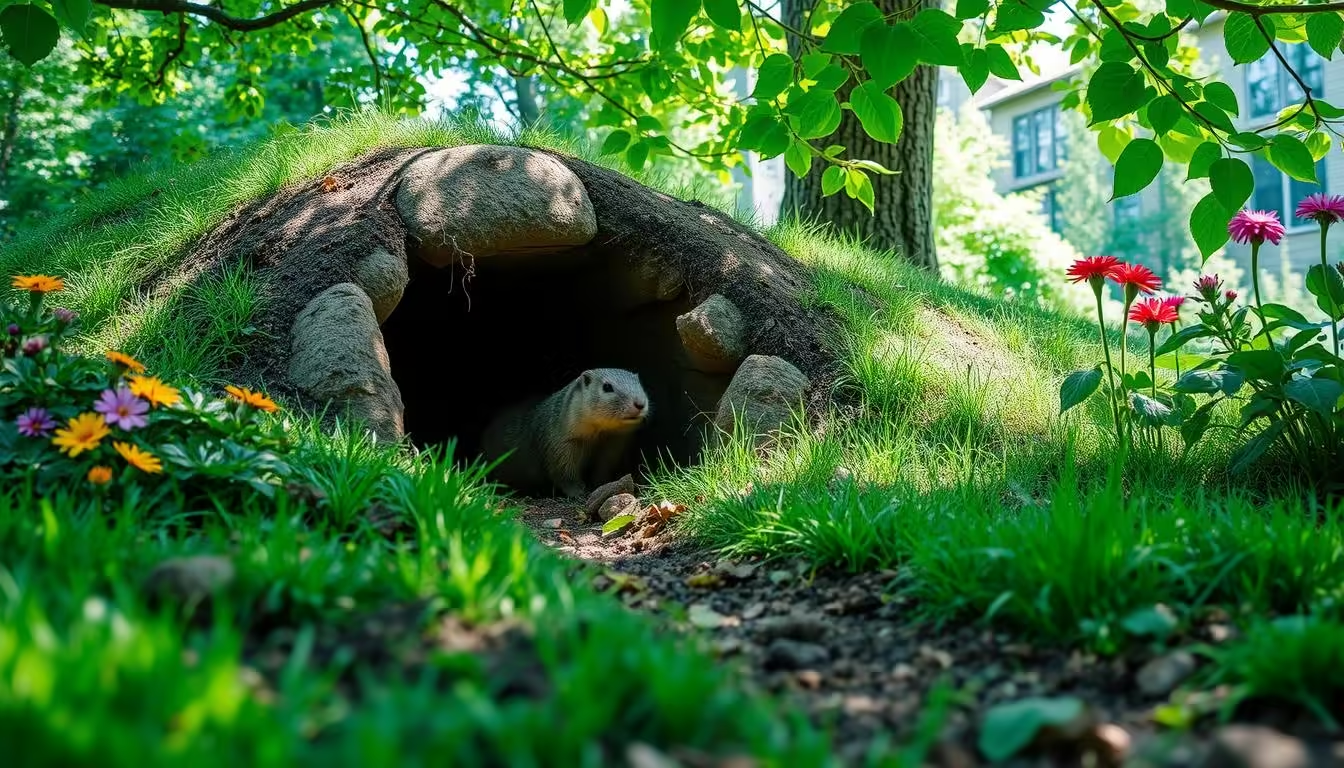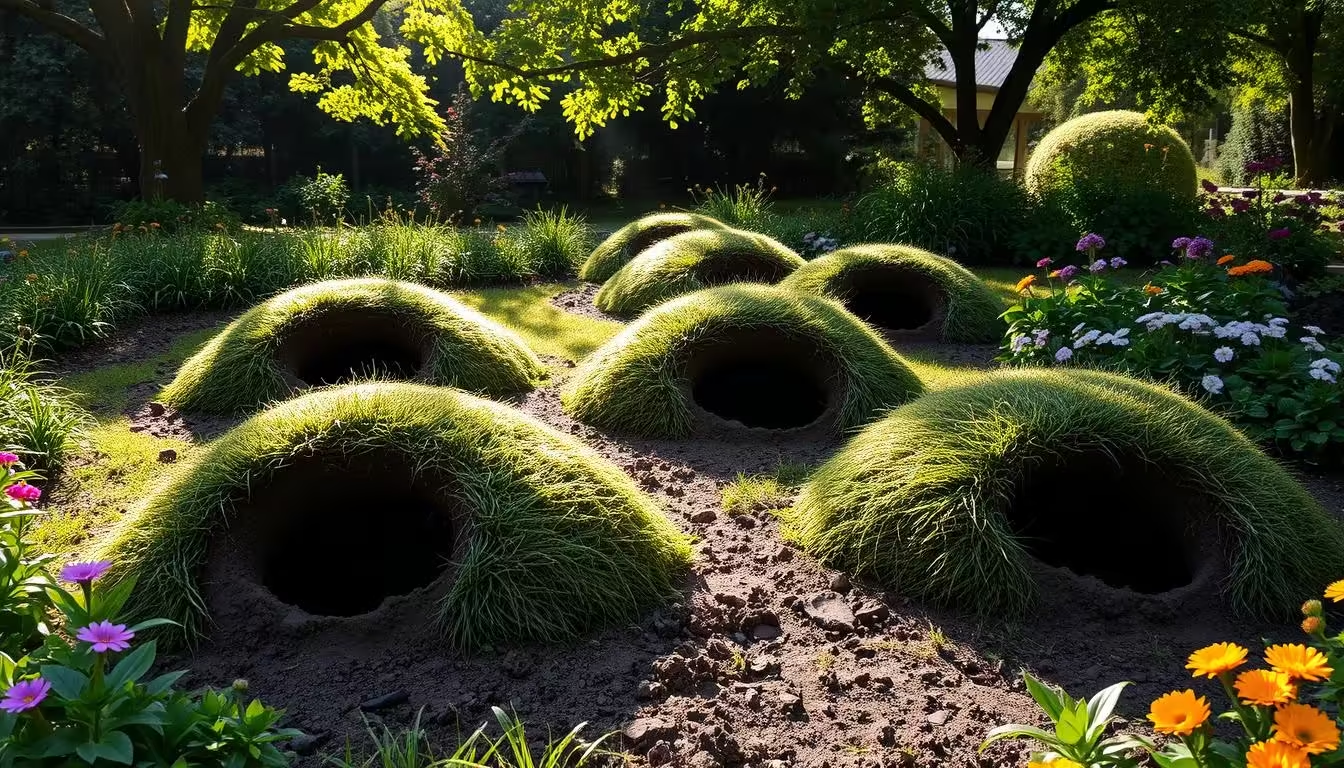Groundhogs, also known as woodchucks or whistle pigs, are native to North America. They are important in our ecosystem. These herbivores eat over 1.5 pounds of leafy plants every day, especially in summer.
Groundhogs are a food source for predators like foxes, bobcats, and eagles. Their burrows also shelter many animals. It’s better to learn how to live with them than to try to get rid of them.
Key Takeaways
- Groundhogs are native to North America and play a vital role in the ecosystem.
- They can cause damage to gardens, but coexistence is essential rather than extermination.
- Groundhogs are herbivores, consuming a significant amount of vegetation daily.
- Their burrow systems provide shelter for various animals, making them an important part of the ecosystem.
- Proper management and prevention strategies can help gardeners and homeowners coexist with groundhogs.
Understanding Groundhog Behavior
Groundhogs are big burrowing animals that can harm gardens and landscapes. To live with them, we need to know what they eat and where they like to be.
What Do Groundhogs Eat?
Groundhogs eat plants like peas, carrots, squash, lettuce, and sunflowers. They can eat a lot in summer, up to 1.5 pounds a day. This helps them gain weight for winter sleep.
Females have 2 to 6 babies a year. These babies need a lot of food too.
Habitat Preferences of Groundhogs
Groundhogs like places with lots of food and good spots to burrow. They like wooded areas close to gardens. Their burrows can be up to 30 feet long and 6 feet deep.
They have many entrances to their burrows. This lets them quickly find food in nearby gardens.
“Groundhogs are efficient herbivores, capable of consuming significant amounts of vegetation to fuel their active lifestyles and prepare for hibernation. Understanding their dietary and habitat preferences is key to effective coexistence with these industrious burrowers.”
Identifying Groundhog Presence in Your Garden
Spotting groundhog signs is the first step to dealing with them in your garden. These animals leave clear marks that show where they’ve been. Knowing these signs helps you act fast to protect your garden.
Signs of Groundhog Activity
- Large, circular holes in the ground with mounds of excavated soil nearby, typically the main burrow entrance
- Trampled or damaged vegetation, including eaten vegetables, fruits, and flowers
- Complex tunnel systems with multiple entrances and exits, some of which may be more concealed
Recognizing Burrowing Patterns
Groundhogs are great at digging, making complex tunnels and chambers. Their burrows have at least two entrances. The main one is easy to spot because of the dirt mound. The secondary entrances are hidden inside the tunnel system.
Research shows that woodchucks typically weigh between 5 and 12 pounds and measure about 16 to 26 inches in length. Their burrows can be up to 45 feet long and 5 feet deep. This shows how big their underground homes can be.
“Groundhog burrows have a large main entrance and often a secondary hidden exit.”
By knowing these signs, you can spot groundhogs in your garden. Then, you can take steps to manage their impact on your outdoor space.
Effective Prevention Strategies
Groundhogs in your garden can be a problem. But, there are ways to keep them away. Fencing and repellents are two effective methods.
Fencing Solutions
A good fence is a strong way to keep groundhogs out. Use 4-foot-high green mesh or chicken wire with small squares. Make sure the fence is wobbly at the top to stop climbing. Also, extend it 12 inches outward at the bottom to prevent burrowing.
For extra protection, consider an electric fence. The shock will keep groundhogs from trying to get in.
Using Repellents
Repellents are also effective against groundhogs. Try kitty litter, capsaicin-based products, or strong-smelling substances like blood meal fertilizer or cayenne pepper. These smells and tastes will keep groundhogs away.
| Groundhog Prevention Method | Effectiveness | Pros | Cons |
|---|---|---|---|
| Fencing | High |
|
|
| Repellents | Moderate |
|
|
Using fencing and repellents together can keep groundhogs out. This way, you can protect your garden and reduce damage.
Designing Your Garden to Deter Groundhogs
Managing groundhogs in your garden starts with smart design. Choose plants that groundhogs don’t like and use physical barriers. This way, you can make your garden less welcoming to these animals.
Plant Selection for Groundhog Resistance
Some plants are not appealing to groundhogs. Herbs like catmint, chives, lavender, lemon balm, and thyme have strong smells that keep them away. Flowers such as coneflowers, snapdragons, dianthus, yarrow, nicotiana, iris, astilbe, and daffodils also help protect your garden.
Planting these resistant species among your veggies creates a barrier. Keeping grass and undergrowth low around buildings also helps keep groundhogs away.
Creating Physical Barriers
Physical barriers are key to keeping groundhogs out. They can fit through openings over 2 inches, so a strong fence is needed. The fence should be at least 3 feet high and wobbly to stop climbing.
Groundhogs have big burrows with many entrances. Burying the fence 1 foot deep blocks their access. This method helps keep your garden safe from groundhogs.
“Groundhogs can weigh up to 13 pounds and range in length from 17 to 24 inches, making them a formidable challenge for gardeners. However, with the right combination of plant selection and physical barriers, you can create a garden that discourages these burrowing animals from taking up residence.”
Safe Trapping Techniques
When dealing with groundhogs in your garden, trapping may become a necessary option. It’s crucial to ensure that any trapping methods employed are safe and humane. Groundhog trapping should be approached with care and consideration for the animal’s well-being.
Choosing the Right Trap
Live cage traps are the recommended choice for humane trapping of groundhogs. These traps are designed to capture the animal without causing harm, allowing for their safe and ethical release. When selecting a trap, choose one that is large enough to accommodate the size of the groundhog and is equipped with a sturdy door mechanism to prevent escape.
Ethical Release Options
Once a groundhog has been trapped, the next step is to determine the best course of action for its ethical animal release. In many areas, it may be illegal to release trapped animals on public land or on other private properties. Before attempting to relocate a trapped groundhog, be sure to check your local regulations and wildlife management guidelines.
If permitted, the groundhog should be transported to a suitable habitat far from residential areas, where it can be released safely and away from potential conflicts with humans. This helps to discourage the groundhog from returning to your garden and encourages it to establish a new home in a more natural environment.
“Humane wildlife trapping involves strategies and devices designed to capture animals without causing harm or stress, ensuring safety and well-being.”
Managing Groundhog Populations
Groundhogs, also known as woodchucks, can be a problem in many gardens and landscapes. They may entertain us as they come out of hibernation. But, their big appetite and digging can damage your outdoor spaces. Knowing local rules and getting professional help are key to managing them.
Understanding Local Regulations
Before acting against groundhogs, learn about local wildlife laws. In some places, there are hunting seasons for them. In cities, killing them might be banned. Talk to your local wildlife agency for advice on how to handle them legally and ethically.
When to Seek Professional Help
If you can’t keep groundhogs away, it’s time to call a Nuisance Wildlife Control Operator (NWCO). These experts are trained to handle wildlife safely and legally. They can give advice, trap them, and move them to a new home. This way, you can enjoy your outdoor space again without harming the animals.
| Groundhog Population Control Methods | Effectiveness | Considerations |
|---|---|---|
| Fencing | High | Requires proper installation and maintenance |
| Repellents | Moderate | May need to be reapplied frequently |
| Live Trapping | High | Requires proper handling and relocation |
| Lethal Control | High | May be restricted in some areas |
Managing groundhogs well means balancing local laws, ethics, and the ecosystem’s health. By knowing your options and getting help when needed, you can live with these animals. This way, you protect your garden and landscape from their damage.
Coexisting with Groundhogs
As cities grow, managing groundhogs is key. These animals are important in the ecosystem. They help other animals by being food and providing homes.
Appreciating Their Role in the Ecosystem
Groundhogs, also known as woodchucks or whistle pigs, are Illinois’ largest squirrel. They can weigh up to 15 pounds and are 2 feet long. They are vital for other animals to eat and live.
Establishing Boundaries
To live with groundhogs, set clear boundaries. Use fencing that’s at least 3 feet tall and angled at 45 degrees. Burying the fence 12 to 14 inches underground helps too. Choose plants that groundhogs don’t like to make your garden less appealing.
By protecting your garden and respecting groundhogs, you can live together. Use fencing, choose plants wisely, and appreciate their role. This way, you can enjoy your outdoor space with groundhogs.
| Groundhog Fact | Value |
|---|---|
| Largest squirrel in Illinois | Yes |
| True hibernators | Yes |
| Litters per year | 1 |
| Typical litter size | 3-5 pups |
| Age of first mating | 2 years |
| Carriers of tularemia bacteria | Yes |
| Minimum fence height to deter | 3 feet |
| Buried fence depth | 12-14 inches |
“Groundhogs are a vital part of the food chain, serving as prey for endangered predators, and their extensive burrow systems provide shelter and habitat for a variety of other wildlife species.”
Educational Resources for Groundhog Lovers
If you love watching groundhogs, there’s a lot to learn. You can find books, websites, and workshops to help you understand these animals better. Whether you garden or love nature, there’s something for you.
Books and Websites for Further Learning
Check out books like “Suburban Backyard Ecosystem: A Guide to Coexisting with Wildlife” and “Groundhogs: Biology, Ecology, and Management”. The Humane Society’s website also has great tips on living with groundhogs. It helps you keep them out of your garden and learn about their importance.
Local Workshops and Community Groups
- Look for local workshops on wildlife-friendly gardening and groundhog management. These hands-on sessions offer real tips for homeowners.
- Join groups like the Groundhog Enthusiasts of America. They host events, field trips, and talks to help you love groundhogs more.
Using these resources, you can learn a lot about groundhogs. You’ll find ways to manage them in your garden and learn to live with them peacefully.
| Educational Resource | Key Takeaways |
|---|---|
| “Suburban Backyard Ecosystem: A Guide to Coexisting with Wildlife” | Comprehensive guide on managing urban wildlife, including groundhogs, with practical strategies for gardeners. |
| Humane Society website | Informative resource on understanding groundhog behavior and establishing boundaries to coexist peacefully. |
| Local conservation group workshops | Hands-on learning opportunities to explore wildlife-friendly gardening and groundhog management techniques. |
| Groundhog Enthusiasts of America | Community group dedicated to fostering appreciation for groundhogs through events, field trips, and discussions. |
“Groundhogs have been observed to create burrows in Washington, D.C., since the Civil War era, demonstrating their resilience and adaptability to urban environments.”
Gardening Techniques to Minimize Damage
Managing groundhogs in your garden can be tough. But, with the right gardening methods, you can reduce the damage they cause. Let’s look at some ways to live with groundhogs and keep your garden healthy.
Companion Planting Ideas
Companion planting is a smart strategy. It involves planting certain plants with your crops to keep groundhogs away. Lavender, marigolds, and castor beans are good choices. They can protect your more delicate plants.
Mulching and Soil Management
Good soil care is key to less groundhog damage. Mulch thickly around your plants to stop groundhogs from digging. Also, keep your soil rich and healthy. This makes your plants stronger against groundhogs.
Raised beds with hardware cloth bottoms are another good idea. They stop groundhogs from digging into your garden. Always watch for signs of groundhogs and act fast to avoid damage.
“By integrating smart gardening techniques, you can create a harmonious coexistence with groundhogs and enjoy a thriving, well-protected garden.”
Monitoring and Evaluation
Keeping an eye on your garden is key to managing groundhogs. Look for signs like fresh burrows, scattered soil, or damaged plants. Keep a log of these sightings, noting when, where, and what you see.
Assessing Garden Changes Over Time
Watch how your garden changes to see if your methods work. Check if fencing or repellents keep groundhogs away. Note where they still show up. This helps you know what works best for your garden.
Adjusting Strategies for Long-Term Success
Use what you learn to change your plan as needed. Groundhogs can find ways around some barriers. By always checking and tweaking your approach, you can keep your garden safe from groundhogs for good.



